Writing about reading is such an important part of becoming an intentional reader – and a stronger writer! Lately, I have been getting so many questions from teachers about how they can better support their students when it comes to reading response activities.
Here are some questions that have come to me lately:
- I’m looking for suggestions on how to be more intentional about having just as much writing to go with my reading. Any ideas would be helpful!
- I know writing about reading is important, but I’m stuck on how!?
- How can I implement writing in small groups?
- In what ways can I give my students accountability for writing about reading?
So all of these questions inspired me to think about how teachers can be more intentional about writing about reading in their classrooms. Today I am going to share five tips with you that I hope will inspire you to make a reading response more meaningful for you and your students!
When we talk about writing about reading or reading response, we refer to an assignment requiring students to respond to something they have read – simple, right!?
Not always. Reading response activities can vary – and they should! It might be a comprehension question that requires students to respond with 2-3 sentences. It could be a prompt that encourages students to write an essay analyzing the character or theme in a story. Or it could be a set of questions asking students to summarize various parts of a text they have read. The possibilities are endless.
A strong written response has two parts:
- strong comprehension skills
- strong writing skills
If your students are lacking in either of these, they will most likely struggle with any reading response activity you give them.
Here are five tips to help your students improve reading comprehension, which ultimately helps them refine their writing skills too:
Tip #1: Provide Scaffolded Support to Help Students Reach Writing Goals
Scaffolding support for your students is like a gradual release. It can be helpful to think backward about what you want the goal for your students is and add in supports to help them get there.
What support can you give your students now to help them reach the ultimate goal?
- Graphic organizers to help with comprehension. This is a great way to help students break down key ideas in a text. Once they can identify the key ideas using a graphic organizer, then they can put those ideas into a written response.
- Give students opportunities to verbalize their responses before writing them down. This could be partner talk or even a whole group discussion. Before students jump into writing a reading response, talking through their ideas allows them to organize their thinking before putting pencil to paper.
- Model. This is so important! Modeling how to respond to a question based on reading properly is such a valuable experience for students. When you model, start with breaking down the question, looking in the text for evidence, planning out a response, and finally answering the question.
- Give sentence frames. Also known as sentence starters, this is a tool to help your students start writing about reading. So many times our students don’t respond because they don’t know where to start! Sentence starters can be as simple as In the text the author wrote.
Sentence Writing Routine Free Sample
If your students struggle to write at the sentence level, this new literacy routine is going to be your new best friend. Each day of the week your students will engage in a quick (yet effective) sentence writing task that will help them become more confident and creative writers. Say goodbye to fragments and boring sentences, and say hello to complex sentences with lots of details!
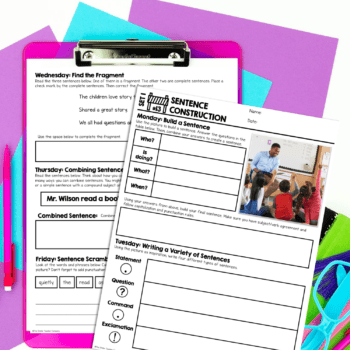
Tip #2: Create Opportunities for Collaboration When Writing About Reading
Collaborative writing can increase students’ creativity and understanding of writing expectations. Students learn how to write for the reader when they share their writing with others. When students first start writing, especially early on, they write what makes sense to them, but that isn’t always the goal of writers. They can reflect on and improve their writing by sharing written responses with other students.
Collaboration on reading response activities might look like:
- Allowing students to work together to write a single response
- Encouraging students to share their writing with partners to get feedback and share ideas
- Building in reflection periods consistently to help familiarize students with the process of sharing
Tip #3: Give Students a Chance to Revise Their Writing About Reading
Revising can be easily overlooked on assignments outside of traditional writing activities. I know when I was in the classroom, we usually revised writing when it was a paragraph or more. But I’ve now learned the importance of letting students revise all writing types, even down to one-sentence answers! Encouraging students to revise on a variety of assignments will help them understand the importance of reviewing what they write.
Revision is a time for students to re-read their writing, improve it, and assess whether it meets the goal of the response. I am going to assume that when you teach your students to write a paragraph or essay, you teach them a structure first, set clear goals, etc. So, when they revise, they know their end goal. This can be done for reading response activities too!
This might look like:
- Talking to students about the importance of reviewing writing consistently
- Showing examples of writing to your students. When you show examples, it is beneficial to show exemplars and flawed examples.
- Revising! Encourage students to revise their writing about reading for word choice, to add details, and extend their ideas.
The more opportunity you give your students to revise any sort of written response, the better they will become at writing. Make it a goal to intentionally revise a question or writing sample at least once a week.
Tip #4: Build in a Variety of Reading Response Assignments
If we want our students to have lots of authentic writing experiences, they need a variety of assignments to show off and hone their skills. Reading response activities can be so diverse! Any writing response to a text can be considered writing about reading. These activities might be sentence-level, paragraphs, or essays. But you can get creative with these assignments too!
Here are a few reading response activity ideas:
- Brainstorm a list of character traits = word choice. I love a quick task like this to help students get their wheels turning about writing! We know strong writers focus on word choice, so instead of asking your students to think about word choice and tackle a paragraph or an essay… simplify it!
- Write a one-sentence summary of the paragraph you just read. I love this idea because it makes students think about what details they will include in that one sentence. Plus, it encourages students to move beyond simple and complex sentences and write compound and complex sentences.
- Write a personal narrative that shares a time you learned the same lesson as the character. With longer reading response assignments we are asking students to put all the strategies they’ve been working on together to write a more in-depth writing piece.
Being thoughtful about they types of reading response assignments we give our students is going to help our students become strong writers – using a variety of list, sentence, paragraph, and essay level writing activities is key!
Tip #5: Avoid Tackling Too Many Objectives at Once
This tip is so important when it comes to supporting your students on their journey to becoming stronger writer. Just like anything we teach our students if you pile on too much, it can be overwhelming for students – and us!
Imagine turning in your first reading response assignment and getting it back covered in red ink, correcting every mistake you made. Defeating, right? Your students will likely have the same reaction! When we teach writing this way, we can leave our students with nothing to feel proud about.
So instead of trying to get your students to work on spelling, punctuation, grammar, sentence variety, etc. all at once – pick 1-2 to focus on at a time. So along with helping them improve, always point out something they have done well so they feel proud about their writing too. This will help them build confidence as writers.
If you want to learn more about these five tips don’t forget to check out Episode 103 of the podcast!
Think about your next steps…
If you are ready to start planning ways to be more intentional about the reading response activities you use in your classroom, you can…
- Download my free Sentence Writing Routine to help your students improve their writing skills at the sentence-level in an engaging, practical way.
- Check out Episode 104: 4 Response Frames That You Can Use When Assigning a Written Response for written response frames that are ready to be implemented today and will help even your reluctant writers get started!
- Join us inside The Stellar Literacy Collective, where you will get access to a resource library filled with reading and writing resources including graphic organizers, writing about reading, and more.
Happy Teaching!


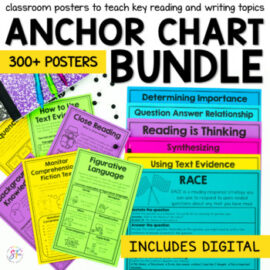
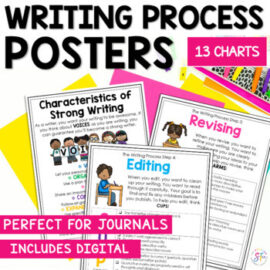
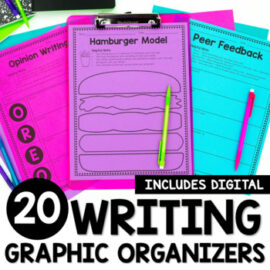

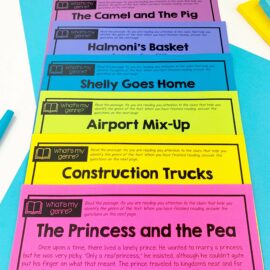
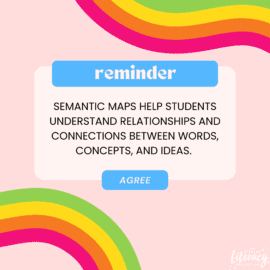









Leave a Comment
You must be logged in to post a comment.